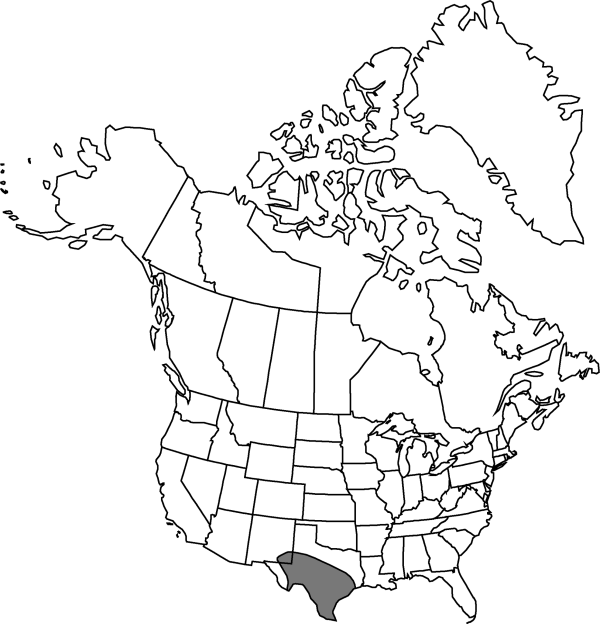Difference between revisions of "Opuntia engelmannii var. lindheimeri"
Madroño 35: 346. 1988.
FNA>Volume Importer |
FNA>Volume Importer |
||
| Line 11: | Line 11: | ||
|name=Opuntia lindheimeri | |name=Opuntia lindheimeri | ||
|authority=Engelmann | |authority=Engelmann | ||
| + | |rank=species | ||
|publication_title=Boston J. Nat. Hist. | |publication_title=Boston J. Nat. Hist. | ||
|publication_place=6: 207. 1850 | |publication_place=6: 207. 1850 | ||
| Line 17: | Line 18: | ||
|name=Opuntia lindheimeri var. lehmannii | |name=Opuntia lindheimeri var. lehmannii | ||
|authority=L. D. Benson | |authority=L. D. Benson | ||
| + | |rank=variety | ||
}} {{Treatment/ID/Synonym | }} {{Treatment/ID/Synonym | ||
|name=Opuntia lindheimeri var. tricolor | |name=Opuntia lindheimeri var. tricolor | ||
|authority=(Griffiths) L. D. Benson | |authority=(Griffiths) L. D. Benson | ||
| + | |rank=variety | ||
}} {{Treatment/ID/Synonym | }} {{Treatment/ID/Synonym | ||
|name=Opuntia subarmata | |name=Opuntia subarmata | ||
| − | |authority= | + | |authority= |
| + | |rank=species | ||
}} {{Treatment/ID/Synonym | }} {{Treatment/ID/Synonym | ||
|name=Opuntia tardispina | |name=Opuntia tardispina | ||
| − | |authority= | + | |authority= |
| + | |rank=species | ||
}} | }} | ||
|hierarchy=Cactaceae;Cactaceae subfam. Opuntioideae;Opuntia;Opuntia engelmannii;Opuntia engelmannii var. lindheimeri | |hierarchy=Cactaceae;Cactaceae subfam. Opuntioideae;Opuntia;Opuntia engelmannii;Opuntia engelmannii var. lindheimeri | ||
| Line 41: | Line 46: | ||
|elevation=0-1900 m | |elevation=0-1900 m | ||
|distribution=La. ;N.Mex.;Tex.;Mexico;South Africa (introduced). | |distribution=La. ;N.Mex.;Tex.;Mexico;South Africa (introduced). | ||
| − | |discussion=<p>L. D. Benson (1982) grouped all large, yellow-spined plants in the Texas region under <i>Opuntia</i> lindheimeri. Plants known as O. lindheimeri var. lehmannii have large, wavy stem segments that are broader than long. <i>Opuntia</i> lindheimeri < | + | |discussion=<p>L. D. Benson (1982) grouped all large, yellow-spined plants in the Texas region under <i>Opuntia</i> lindheimeri. Plants known as O. lindheimeri var. lehmannii have large, wavy stem segments that are broader than long. <i>Opuntia</i> lindheimeri <i></i>var.<i> tricolor</i> (Griffiths) L. D. Benson is a morphotype with long, yellow spines to 75 mm; and O. subarmata Griffiths is a morphotype with spineless or nearly spineless stems.</p><!-- |
--><p>Although <i>Opuntia engelmannii </i>var.<i> lindheimeri</i> is a hexaploid, like the rest of O. engelmanni, several individuals were recorded as 2n = 22, 44, and ca. 44; however, such numbers require taxon verification.</p><!-- | --><p>Although <i>Opuntia engelmannii </i>var.<i> lindheimeri</i> is a hexaploid, like the rest of O. engelmanni, several individuals were recorded as 2n = 22, 44, and ca. 44; however, such numbers require taxon verification.</p><!-- | ||
--><p><i>Opuntia engelmannii </i>var.<i> lindheimeri</i> hybridizes with <i>O. stricta</i>, forming hexaploid O. ×alta Griffiths, and with <i>O. macrorhiza</i> Engelmann, forming pentaploid O. ×edwardsii V. E. Grant & K. A. Grant.</p> | --><p><i>Opuntia engelmannii </i>var.<i> lindheimeri</i> hybridizes with <i>O. stricta</i>, forming hexaploid O. ×alta Griffiths, and with <i>O. macrorhiza</i> Engelmann, forming pentaploid O. ×edwardsii V. E. Grant & K. A. Grant.</p> | ||
| Line 52: | Line 57: | ||
-->{{#Taxon: | -->{{#Taxon: | ||
name=Opuntia engelmannii var. lindheimeri | name=Opuntia engelmannii var. lindheimeri | ||
| − | |||
|authority=(Engelmann) B. D. Parfitt & Pinkava | |authority=(Engelmann) B. D. Parfitt & Pinkava | ||
|rank=variety | |rank=variety | ||
| Line 67: | Line 71: | ||
|publication year=1988 | |publication year=1988 | ||
|special status= | |special status= | ||
| − | |source xml=https://jpend@bitbucket.org/aafc-mbb/fna-data-curation.git/src/ | + | |source xml=https://jpend@bitbucket.org/aafc-mbb/fna-data-curation.git/src/f50eec43f223ca0e34566be0b046453a0960e173/coarse_grained_fna_xml/V4/V4_255.xml |
|subfamily=Cactaceae subfam. Opuntioideae | |subfamily=Cactaceae subfam. Opuntioideae | ||
|genus=Opuntia | |genus=Opuntia | ||
Revision as of 21:38, 16 December 2019
Stem segments broadly obovate to subcircular, 15–30 × 12.5–25 cm, sometimes broader than wide, to 1.5 times longer than wide. Spines (0–)1–6 per areole, evenly distributed on stem segment to absent, yellow throughout, sometimes with red or red-brown extreme bases, aging blackish, longest 12–75 mm. 2n = 66.
Phenology: Flowering spring (Mar–Jun).
Habitat: Chihuahuan Desert, plains to woodlands and chaparral, sandy to gravelly or rocky soils
Elevation: 0-1900 m
Distribution

La., N.Mex., Tex., Mexico, South Africa (introduced).
Discussion
L. D. Benson (1982) grouped all large, yellow-spined plants in the Texas region under Opuntia lindheimeri. Plants known as O. lindheimeri var. lehmannii have large, wavy stem segments that are broader than long. Opuntia lindheimeri var. tricolor (Griffiths) L. D. Benson is a morphotype with long, yellow spines to 75 mm; and O. subarmata Griffiths is a morphotype with spineless or nearly spineless stems.
Although Opuntia engelmannii var. lindheimeri is a hexaploid, like the rest of O. engelmanni, several individuals were recorded as 2n = 22, 44, and ca. 44; however, such numbers require taxon verification.
Opuntia engelmannii var. lindheimeri hybridizes with O. stricta, forming hexaploid O. ×alta Griffiths, and with O. macrorhiza Engelmann, forming pentaploid O. ×edwardsii V. E. Grant & K. A. Grant.
Selected References
None.